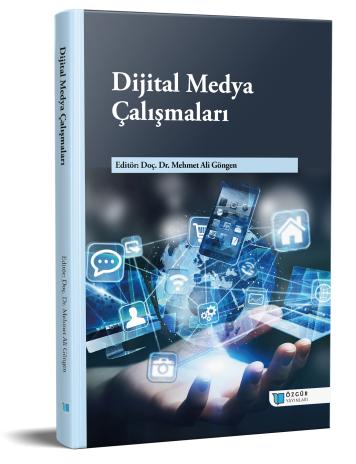
Dijital Medya Çalışmaları
İndir
Özet
Üretim temelinde çağlara bölünen insanlık tarihi günümüzde yeni bir durumla karşı karşıyadır. Dijital alanda var olanlar ve dijital alanda var olmayanların oluşturduğu bu yeni çağın adı çoktan konuldu: Dijital çağ. “we are social” 2023 raporuna göre 2023 yılı itibariyle Dünya çapında sosyal medya kullanımı 4.76 milyara ulaşmıştır. Aynı rapora göre 5.16 milyar internet kullanıcısı bulunmaktır. Bu veriler sırasıyla Dünya nüfusunun %59.4 ve %64.4’üne tekabül etmektedir. Bu dijital çağda teknolojik gelişmelerin temelini oluşturan aslında yine üretimdir. Bu konuda insanlık tarihinde üretimin belirlediği ilişki biçimlerinde değişen bir şey yok. Yeni olan materyal üretimin yerini bilgi üretimine bırakması, yani somuttan soyuta doğru gücün evrilmesidir. Baudrillard’ın “gerçek simülasyona dönüştü…..yaşadığımız evren simülasyon evrenidir” diyerek işaret ettiği insan beyninin bir uzantısı olarak gelişen teknolojinin bütün ilişki biçimlerini yeniden dizayn etmesidir.
Dijital çağ, bütün üretim araçlarını, üretim biçimlerini, toplumsal ilişkileri ve genel anlamda güç ilişkilerini yeniden şekillendirirken iletişim pratikleri ve medya çalışmalarında da dönüşüme sebep olmuştur. Manuell Castells toplumsal dönüşümü toplumsal bir formasyon olarak 'Ağ Toplumu' kavramsallaştırmasıyla ifade etmiştir.
Bu kitap çalışması dijital çağın medya ayağına ilişkin çalışmalar içermektedir “Panoptikon’dan dijital gözetim toplumuna yeni medya” başlıklı çalışmasında Nihal Kocaağa ve Ensar Lokmanoğlu, modern ve postmodern toplumlarda gözetim pratiklerine odaklanırken, her iki dönemde de gözetleme olgusu yaşanmakla birlikte postmodern dönemde daha yıkıcı ve bireylerin bilerek katkıda bulundukları bir sürece evrildiği sonucuna varmıştır. Teorik bir bağlamda tartışılan gözetleme olgusu, yeni dijital çağ ile birlikte sınırsız bir şekilde kapitalizm lehine hemen her alanda ve hemen herkes üzerinde işletilen bir duruma dönüşmüştür.
“Computational Communication Studies: The Era of Digital Research” başlıklı çalışması ile Vahit Çalışır, dijital araçların ve metodolojilerin ortaya çıkışının iletişim araştırmalarında yol açtığı dönüştürücü değişimi ele alıyor. Aynı zamanda yazar, iletişim çalışmalarındaki sayısal yaklaşımların tarihsel gelişimini özetlemekte ve modern medya ortamlarının karmaşık dinamiklerini anlamadaki öneminin altını çizmektedir.
Zafer Haklı, internet ortamında metinlerin etkisini en üst düzeye çıkarmak için kullanılan web tipografisini incelemiş, web tipografisinin tarihsel gelişimini, önemini, kullanım alanlarını, araçlarını ve hatalarını ele almıştır. Özen Baş ve Perrin Öğün Emre Üniversite Öğrencileri arasında Dijital Şiddete maruz kalma yaygınlığı ve mücadele yöntemleri üzerine yaptığı çalışma dar bir bölge ile sınırlı olsa da Üniversite öğrencilerinin bu alanda farkındalıklarının üst düzeyde olduğunu ortaya koymuştur. Meryem Altıntaş, Sosyal Medyada kadın cinayetlerinin ele alınış biçimlerini incelemiş, yapay zeka yoluyla konuşturulan fotoğrafların olumsuz etkilerine dikkat çekilmiştir.
Dijital yayın platformlarının yayına başlamasının dizi yapım dinamiklerinde meydana getirdiği değişimi inceleyen Sezen Kayhan, araştırma kapsamında, hem televizyon hem de dijital yayın platformu dizilerinin yaratıcı ve teknik ekiplerinde yer almış 13 katılımcı ile görüşmeler yapılmıştır. Araştırma sonucunda dijital yayın platformlarının yayına başlaması, sektör çalışanlarının çalışma şartlarında kısmen iyileşmesini neden olduğu saptanmış ama ekonomik ve politik müdahalelerin hala sorun olduğu ortaya konmuştur.
Dijital Medya Konusunun Halkla ilişkiler alanında yazılmış lisansüstü tezlere yansımasına konu alan Mehtap Uyar, bunun için 2019-2023 yılları arasında yazılmış 132 Yüksek Lisans ve 40 doktora tezini incelemiştir. Çalışma sonucunda, öğrencilerin dijital medya kapsamında sırasıyla en çok dijital medyanın / sosyal medyanın rolü ile dijital medya / sosyal medya kullanımı konularını çalışmayı tercih ettiği görülmüştür. Yazara göre, bundan sonraki çalışmaların disiplinerarası bir anlayışla yapılması literatüre daha fazla katkı sunması bağlamında önemli olacaktır.
Bu kitapta, Dijital medya çalışmaları dışında kalan ancak iletişim alanına giren iki çalışmaya daha yer verdik. Bunlardan birincisi, George Simmel çatışma düşüncesinde yola çıkarak Joker filminin analizini yapan Aziz Tamer Güler’e ait. Çalışmada Güler, Sosyolog Simmer’ın yanısıra Henri lefebvre ve Max Horkheimer gibi düşünürlerden de yararlanarak, gündelik yaşam, anlam ve çatışma kavramlarını Joker filmi üzerinden eleştirel bir perspektifle irdelemektedir. Son olarak H. Buluthan Çetintaş “Sürdürülebilirlilik İletişimi” başlıklı çalışmasıyla, “sürdürülebilirlik” ve “sürdürülebilir kalkınma kavramları”, “kurumsal sürdürülebilirlik” kavramları ve “sürdürülebilirlik iletişimi” kavramı açıklanmış, değerlendirmeler yapılmış ve gelecek çalışmalar için önerilerde bulunulmuştur.
Dijital medya çalışmaları ile ilgili farklı konuları içeren bu çalışmanın alanına katkı sunmasını ümit ediyoruz.
Doç. Dr. Mehmet Ali Göngen
Ekim, 2023/ Gaziantep

